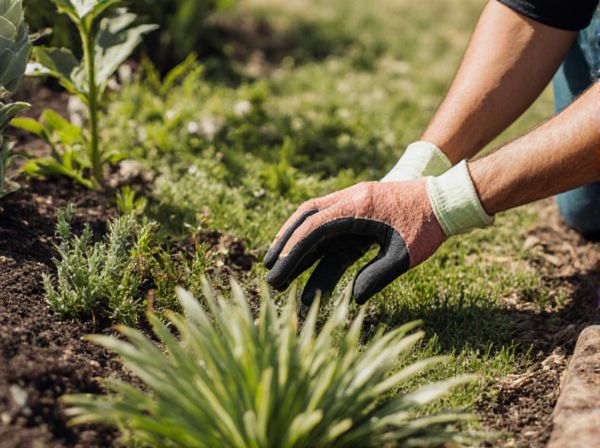
Xeriscaping vs Traditional Planting Illustration
Xeriscaping conserves water by using drought-tolerant plants and efficient irrigation, making it ideal for arid climates or water-restricted areas. Traditional planting often requires regular watering and maintenance, relying on a variety of plant species regardless of their water needs. Choosing xeriscaping over traditional planting enhances sustainability while reducing water bills and environmental impact.
Table of Comparison
| Feature | Xeriscaping | Traditional Planting |
|---|---|---|
| Water Usage | Low; drought-resistant plants minimize irrigation | High; often requires frequent watering |
| Plant Types | Native, drought-tolerant species | Wide variety including non-native, water-dependent plants |
| Maintenance | Minimal; less mowing and fertilization | Regular; mowing, pruning, fertilizing needed |
| Cost | Initial setup may be higher; lower long-term costs | Lower setup; higher ongoing maintenance expenses |
| Environmental Impact | Promotes water conservation and biodiversity | May increase water use and chemical inputs |
| Aesthetics | Natural, sustainable beauty with native plants | Traditional lush, varied garden styles |
Introduction to Xeriscaping and Traditional Planting
Xeriscaping is a landscaping method designed to reduce or eliminate the need for irrigation by using drought-resistant plants, efficient soil amendments, and strategic plant placement. Traditional planting relies on conventional gardening techniques that often require regular watering, fertilization, and maintenance to support a variety of ornamental plants. Choosing xeriscaping can significantly conserve water and reduce maintenance costs while maintaining aesthetic appeal in ornamental landscapes.
Water Usage: Xeriscaping vs Traditional Approaches
Xeriscaping significantly reduces water consumption by utilizing drought-tolerant native plants and efficient irrigation methods, often cutting water use by up to 50-75% compared to traditional planting. Traditional landscaping relies heavily on regular watering schedules and water-intensive lawns, leading to higher overall water demand. Implementing xeriscaping techniques contributes to sustainable water management and minimizes the environmental impact of ornamental gardens.
Soil Preparation and Amendments
Xeriscaping requires soil preparation that emphasizes improving drainage and increasing organic matter to retain moisture, often incorporating materials like compost and mulch tailored to arid conditions. Traditional planting typically involves more extensive soil tilling and the use of balanced fertilizers to support nutritional needs in more water-abundant environments. Effective amendments in xeriscaping include gypsum and sand to enhance soil porosity, while traditional methods prioritize nutrient-rich amendments such as peat moss and nitrogen-based fertilizers.
Plant Selection for Ornamental Appeal
Xeriscaping emphasizes drought-tolerant plants such as succulents, ornamental grasses, and native wildflowers that provide year-round interest with minimal water use. Traditional planting often prioritizes a broader variety of species, including water-loving ornamentals like azaleas and hydrangeas, requiring more frequent irrigation. The selection in xeriscaping focuses on hardiness and texture, creating visually appealing landscapes with resilient, low-maintenance plants.
Maintenance Requirements: Time and Effort
Xeriscaping significantly reduces maintenance requirements by utilizing drought-tolerant plants and efficient irrigation methods, leading to less frequent watering and minimal pruning. Traditional planting often demands consistent watering, fertilizing, and weed control, increasing time and labor investment. Homeowners seeking low-maintenance ornamental landscaping benefit from xeriscaping's sustainable, resource-efficient approach.
Cost Comparison: Installation and Long-Term Savings
Xeriscaping reduces initial installation costs by minimizing the need for extensive irrigation systems and replacing high-maintenance plants with drought-tolerant species. Traditional planting often incurs higher water bills and maintenance expenses due to frequent watering, fertilizing, and pruning. Over time, xeriscaping delivers significant long-term savings by conserving water and reducing the reliance on fertilizers and pesticides.
Environmental Impact and Sustainability
Xeriscaping significantly reduces water consumption by utilizing drought-tolerant plants and efficient irrigation techniques, making it a sustainable alternative to traditional planting that often requires extensive watering and chemical inputs. It lowers environmental impact through decreased runoff and minimized fertilizer use, promoting healthier soil and biodiversity. Traditional planting can increase water waste and pollution, whereas xeriscaping supports conservation efforts crucial for arid and drought-prone regions.
Seasonal Interest and Landscape Design
Xeriscaping enhances seasonal interest by incorporating drought-tolerant plants that offer vibrant textures and colors throughout the year, reducing water use while maintaining aesthetic appeal. Traditional planting often relies on water-intensive species that deliver bold floral displays in peak seasons but may face drought stress or decline in less favorable conditions. Integrating xeriscape principles into landscape design promotes year-round resilience and sustainable beauty without sacrificing dynamic seasonal variation.
Common Challenges and Solutions
Xeriscaping often faces challenges like soil quality issues, limited plant variety, and initial establishment costs but mitigates these through drought-tolerant native species and efficient irrigation systems. Traditional planting struggles with water overuse, pest susceptibility, and maintenance demands, which can be addressed by integrated pest management and sustainable watering practices. Both methods require tailored soil amendments and strategic plant selection to optimize growth and resource efficiency in ornamental landscaping.
Choosing the Best Approach for Your Garden
Xeriscaping offers significant water conservation benefits by selecting drought-tolerant plants and reducing irrigation needs, making it ideal for arid regions or water-restricted areas. Traditional planting allows for a broader variety of ornamental species that thrive in well-watered conditions, supporting vibrant and diverse garden aesthetics. Assessing local climate, soil conditions, and water availability is crucial for choosing the best approach to ensure a sustainable and visually appealing garden.
Xeriscaping vs Traditional Planting Infographic

 gardendif.com
gardendif.com